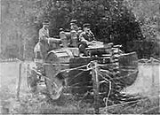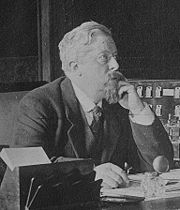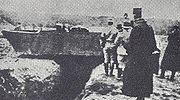
Breton-Prétot machine
Encyclopedia
The Breton-Prétot machine was a wire-cutting armoured vehicle developed in France
from November 1914. The vehicle was developed by Mr. Prétot, engineer, and Jules-Louis Breton
, representative to the French Assembly.
characterizing the First World War led to a need for a powerfully armed military engine that would be at the same time protected from enemy fire and could move on the extremely irregular terrain of battlefields. Barbed wire
especially posed a considerable threat as it was cheap and easy to install, extremely effective at slowing or stopping an offensive by troops against protected fire, and very difficult to eliminate, even with artillery. Special machines were considered to attempt to eliminate this problem: armoured, armed vehicles, with a capacity to flatten or otherwise eliminate barbed-wire lines.
 The Breton-Prétot machine was equipped with a saw to cut the barbed wire
The Breton-Prétot machine was equipped with a saw to cut the barbed wire
protecting enemy trenches of World War I
. The first version consisted of a small circular saw, driven by a six hp engine, attached to a long lever that was placed on a small cart with four wheels, that had to be pushed towards its objective. Breton proposed the machine to the French government in November 1914 and a prototype was tried in January 1915, when it was shown that the system in this form had little practicality. The use of caterpillar tracks was discussed that same month, but since none were available at that time, the system was then mounted at Liancourt
on the back of a Bajac tractor in order to obtain all-terrain mobility, towards the end of February 1915. The small circular saw was replaced by a large vertical saw with thirteen teeth, but a larger horizontal circular saw was added, just above ground level to cut the barbed-wire poles. In July the system was again changed, the horizontal saw being left out and large deflection shields being placed to protect the wheels. Eight small bronze cannon were used as simulation weights.
After satisfactory tests on 22 July 1915, at Maison-Lafitte, the War Minister, Alexandre Millerand
, ordered ten armoured and armed wire-cutters to be manufactured on 7 August.
company which was working on the caterpillar track system, under a production licence from the American Holt Manufacturing Company. Experiments with the Holt caterpillar tracks had started in May 1915 at the Schneider plant with a 75 hp wheel-directed model and the 45 hp integral caterpillar Baby Holt, showing the superiority of the latter. On 16 June, new experiments had followed in front of the President of the Republic
, and again on 22 July 1915 in front of War Minister Millerand, who decided on 7 August 1915 on the construction of 10 armoured and armed Breton-Prétot machines. For his machine, Breton was thus allowed to order ten Holt tractors, to use as a base for his wire-cutting machine,. Experiments again took place on 10 September for Commander Ferrus. This order was modified on 7 December 1915 into an order to re-use the caterpillars to produce the first Schneider CA1
tanks.
 Finally, on 9 December 1915 at Souain, on a former battlefield with rough terrain and trenches, and in the presence of General Philippe Pétain
Finally, on 9 December 1915 at Souain, on a former battlefield with rough terrain and trenches, and in the presence of General Philippe Pétain
, a prototype armoured vehicle
motorized with a Baby Holt caterpillar was tested, with provisions to attach Breton's wire cutting apparatus to it. Only later, in early 1916, would such a device be actually attached during experiments.
These very encouraging tests prompted General Estienne
to make a formal proposal on 12 December 1915 to build tanks based on a modified, lengthened, Holt caterpillar. The ten Holt tractors were thus finally diverted to the production of the first French tanks of the Schneider CA1
model. The tanks were not equipped with the Breton-Prétot saw, as tests had shown that their tracks alone were sufficient to destroy barbed-wire.
Because of the connection with the Breton-Prétot saw, Breton convinced himself he had become the leading French expert on armoured vehicle design and considered himself to be the true inventor of the French tank. He felt rather piqued when Estienne took over "his" project. This caused him to cooperate with a rival of Estienne, Colonel Émile François Léon Rimailho, in the development of the alternative Char Saint Chamond. In 1917 an Allied inter-parliamentary commission even concluded that Breton had a better claim to the invention of the tank than the British. In the postwar controversy on this subject Breton vociferously defended his position. Modern historians however, agree that the claim is unfounded.
France
The French Republic , The French Republic , The French Republic , (commonly known as France , is a unitary semi-presidential republic in Western Europe with several overseas territories and islands located on other continents and in the Indian, Pacific, and Atlantic oceans. Metropolitan France...
from November 1914. The vehicle was developed by Mr. Prétot, engineer, and Jules-Louis Breton
Jules-Louis Breton
Jules-Louis Breton was a chemist-inventor and a French politician. He was a representative of the French Assembly, and the proponent of the Breton-Pretot machine, a wire-cutting armoured vehicle developed in France from November 1914. The vehicle was developed with M...
, representative to the French Assembly.
Background
The immobility of the trench warfareTrench warfare
Trench warfare is a form of occupied fighting lines, consisting largely of trenches, in which troops are largely immune to the enemy's small arms fire and are substantially sheltered from artillery...
characterizing the First World War led to a need for a powerfully armed military engine that would be at the same time protected from enemy fire and could move on the extremely irregular terrain of battlefields. Barbed wire
Barbed wire
Barbed wire, also known as barb wire , is a type of fencing wire constructed with sharp edges or points arranged at intervals along the strand. It is used to construct inexpensive fences and is used atop walls surrounding secured property...
especially posed a considerable threat as it was cheap and easy to install, extremely effective at slowing or stopping an offensive by troops against protected fire, and very difficult to eliminate, even with artillery. Special machines were considered to attempt to eliminate this problem: armoured, armed vehicles, with a capacity to flatten or otherwise eliminate barbed-wire lines.
Wheel tractor base

Barbed wire
Barbed wire, also known as barb wire , is a type of fencing wire constructed with sharp edges or points arranged at intervals along the strand. It is used to construct inexpensive fences and is used atop walls surrounding secured property...
protecting enemy trenches of World War I
World War I
World War I , which was predominantly called the World War or the Great War from its occurrence until 1939, and the First World War or World War I thereafter, was a major war centred in Europe that began on 28 July 1914 and lasted until 11 November 1918...
. The first version consisted of a small circular saw, driven by a six hp engine, attached to a long lever that was placed on a small cart with four wheels, that had to be pushed towards its objective. Breton proposed the machine to the French government in November 1914 and a prototype was tried in January 1915, when it was shown that the system in this form had little practicality. The use of caterpillar tracks was discussed that same month, but since none were available at that time, the system was then mounted at Liancourt
Liancourt
See also Liancourt RocksLiancourt is a town in northern France. It is designated municipally as a commune within the département of Oise.-References:*...
on the back of a Bajac tractor in order to obtain all-terrain mobility, towards the end of February 1915. The small circular saw was replaced by a large vertical saw with thirteen teeth, but a larger horizontal circular saw was added, just above ground level to cut the barbed-wire poles. In July the system was again changed, the horizontal saw being left out and large deflection shields being placed to protect the wheels. Eight small bronze cannon were used as simulation weights.
After satisfactory tests on 22 July 1915, at Maison-Lafitte, the War Minister, Alexandre Millerand
Alexandre Millerand
Alexandre Millerand was a French socialist politician. He was President of France from 23 September 1920 to 11 June 1924 and Prime Minister of France 20 January to 23 September 1920...
, ordered ten armoured and armed wire-cutters to be manufactured on 7 August.
Caterpillar base
The Bajac agricultural tractor however proved not mobile enough — the initial experiment had only tested the wire-cutting ability — and had the severe disadvantage of having to approach the enemy lines driving backwards. Breton and Prétot then considered using some of the two hundred American four-wheel drive Jeffery tractors that had been commanded by the French Artillery. When this was refused, Commandant Boissin directed Breton to the SchneiderSchneider
Schneider is a surname, common in Germany, it may also refer to:Companies and organizations* G. Schneider & Sohn, Bavarian brewery company* Schneider Rundfunkwerke AG, former owner of the Dual brand record players...
company which was working on the caterpillar track system, under a production licence from the American Holt Manufacturing Company. Experiments with the Holt caterpillar tracks had started in May 1915 at the Schneider plant with a 75 hp wheel-directed model and the 45 hp integral caterpillar Baby Holt, showing the superiority of the latter. On 16 June, new experiments had followed in front of the President of the Republic
Raymond Poincaré
Raymond Poincaré was a French statesman who served as Prime Minister of France on five separate occasions and as President of France from 1913 to 1920. Poincaré was a conservative leader primarily committed to political and social stability...
, and again on 22 July 1915 in front of War Minister Millerand, who decided on 7 August 1915 on the construction of 10 armoured and armed Breton-Prétot machines. For his machine, Breton was thus allowed to order ten Holt tractors, to use as a base for his wire-cutting machine,. Experiments again took place on 10 September for Commander Ferrus. This order was modified on 7 December 1915 into an order to re-use the caterpillars to produce the first Schneider CA1
Schneider CA1
The Schneider CA1 was the first French tank. It was inspired by the need to overcome the stalemate of the trench warfare of the Great War.-Caterpillar development:...
tanks.
Souain experiment

Philippe Pétain
Henri Philippe Benoni Omer Joseph Pétain , generally known as Philippe Pétain or Marshal Pétain , was a French general who reached the distinction of Marshal of France, and was later Chief of State of Vichy France , from 1940 to 1944...
, a prototype armoured vehicle
Souain experiment
The Souain experiment was a French military experiment using a prototype tank, in the former battlefield of Souain, in northeastern France, on 9 December 1915. The experiment has a decisive influence of the French tank program and initiated the design and order of the first French operational tank,...
motorized with a Baby Holt caterpillar was tested, with provisions to attach Breton's wire cutting apparatus to it. Only later, in early 1916, would such a device be actually attached during experiments.
These very encouraging tests prompted General Estienne
Estienne
Estienne, or Etienne is the French form of the name of a French family of scholars and printers. Members are* Henri Estienne, founder of the dynasty * Robert Estienne...
to make a formal proposal on 12 December 1915 to build tanks based on a modified, lengthened, Holt caterpillar. The ten Holt tractors were thus finally diverted to the production of the first French tanks of the Schneider CA1
Schneider CA1
The Schneider CA1 was the first French tank. It was inspired by the need to overcome the stalemate of the trench warfare of the Great War.-Caterpillar development:...
model. The tanks were not equipped with the Breton-Prétot saw, as tests had shown that their tracks alone were sufficient to destroy barbed-wire.
Because of the connection with the Breton-Prétot saw, Breton convinced himself he had become the leading French expert on armoured vehicle design and considered himself to be the true inventor of the French tank. He felt rather piqued when Estienne took over "his" project. This caused him to cooperate with a rival of Estienne, Colonel Émile François Léon Rimailho, in the development of the alternative Char Saint Chamond. In 1917 an Allied inter-parliamentary commission even concluded that Breton had a better claim to the invention of the tank than the British. In the postwar controversy on this subject Breton vociferously defended his position. Modern historians however, agree that the claim is unfounded.

